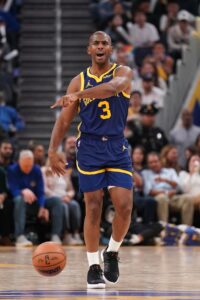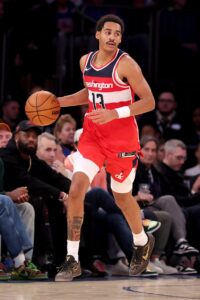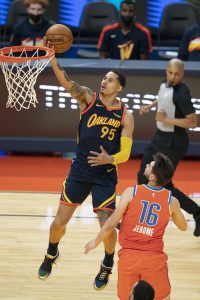This is the third entry in our series breaking down the significant trades of the 2023 offseason. As opposed to giving out grades, this series explores why the teams were motivated to make the moves. Let’s dive into a blockbuster deal between the Warriors and Wizards…
On July 6:
- The Warriors acquired Chris Paul.
- The Wizards acquired Jordan Poole, Patrick Baldwin Jr., Ryan Rollins, the Warriors’ 2030 first-round pick (top-20 protected), the Warriors’ 2027 second-round pick, and cash.
- Note: The Wizards created a $3,344,643 traded player exception as part of this deal, which is the difference between Paul’s outgoing salary ($30,800,000) and the incoming salary of Poole ($27,455,357). Baldwin ($2,337,720) and Rollins ($1,719,864) were acquired via existing TPEs.
The Warriors’ perspective:
 Poole being traded was seemingly inevitable as soon as the Warriors lost in the second round of the 2022/23 playoffs, with the young guard struggling mightily throughout the postseason. It had been clear for a while that it was probably going to come down to moving Poole or Draymond Green, whom the team re-signed to a four-year, $100MM contract in free agency.
Poole being traded was seemingly inevitable as soon as the Warriors lost in the second round of the 2022/23 playoffs, with the young guard struggling mightily throughout the postseason. It had been clear for a while that it was probably going to come down to moving Poole or Draymond Green, whom the team re-signed to a four-year, $100MM contract in free agency.
The Warriors needed to reconfigure their chemistry and on-court results following an uneven attempt to repeat as champions last season. Instead of moving on from a core member of their dynasty, they traded Poole.
That really wasn’t much of a choice – Green has arguably been the best defensive player in the league over the past decade, helping Golden State reach six NBA Finals and win four championships, and Stephen Curry has referred to him as his favorite teammate.
Green has made plenty of poor decisions over the years – he’s annually one of the league leaders in technical fouls and has been suspended multiple times in the regular season and playoffs. Blowing up the Warriors’ season before it even began by punching a teammate he had previously mentored was a new low. And despite plenty of media grandstanding, he never publicly or privately apologized to Poole, according to Logan Murdock of The Ringer.
The organization has always catered to Green, as he didn’t even face punishment for the incident other than an undisclosed fine. Following a string of incidents in ’23/24, he received an indefinite suspension to (perhaps) address some of the underlying causes for his reckless behavior.
It’s worth noting that Green will make less money than Poole ($123MM+) over the next four years as well. Future payroll considerations played a significant factor in this deal, as owner Joe Lacob acknowledged in September.
The Warriors have had record-setting luxury tax bills for multiple years running, but Lacob has said they hope to be below the second tax apron in ‘24/25. Paul’s $30MM salary for ‘24/25 is non-guaranteed, while Poole will be in the second year of his rookie scale extension.
Even if Golden State wins the title in ‘23/24 – which is looking extremely unlikely at this point — I’d be shocked if the team guarantees Paul’s salary for next season. The only way that would make sense would be if the Warriors trade him for a roster upgrade in the offseason, but that would probably require taking on long-term money, which they’ve said they want to avoid.
That doesn’t mean the Warriors can’t try to re-sign Paul at a lower figure, assuming things turn around and he’s open to it. That would require a major discount though, as they’ll lose his Bird rights if they waive him — they’d likely be limited to offering him a minimum-salary deal unless they remove additional salary from their books.
The logic behind this trade made sense for the Warriors, but I’m sure it was painful to move Poole so soon after extending him, even if they view Paul as a short-term upgrade. That’s reasonable enough.
Paul is one of the greatest point guards in NBA history, earning 12 All-Star berths, 11 All-NBA nods, and nine All-Defensive spots over the course of his 18 seasons. He has led the league in steals per game six times and assists per game five times, with three of those seasons overlapping.
Despite being 38 years old, Paul remains a clear upgrade over Poole in several areas. He’s a better rebounder, and there’s not so much a gap as a chasm between Paul’s defense, decision-making, passing, and ability to take care of the ball compared to Poole’s. Paul is nicknamed “the Point God” for a reason.
Turnovers were a major problem for the Warriors in ‘22/23, with the team ranking 29th in the league with a 15.8% turnover percentage. Poole was a major contributor to that, averaging 3.1 turnovers per game — second-most on the team behind Curry — and posting a 1.46-to-1 assist-to-turnover ratio, slightly worse than his career mark (1.61-to-1).
Remarkably, Paul has had an assist-to-turnover ratio below 3-to-1 only once in his career – back in 2019/20 with OKC, when he shared ball-handling duties and was more focused on scoring. And even then, it was just barely under (2.93-to-1). For his career, he’s at 3.98-to-1. Last season: 4.6-to-1. So far in ‘23/24: 6-to-1.
While it’s true that the Warriors had to attach some marginal assets to move Poole’s long-term contract, this trade does show one of the fringe benefits of rookie scale extensions: Having his salary already locked in for ’24/25 meant that Golden State didn’t have to deal with restricted free agency or work out a sign-and-trade, which is much more complicated, especially for the league’s biggest spenders.
He has never won a title, but Paul’s teams have made the playoffs 15 times in his 18 years in the league, including the last 13 seasons in a row.
His elite basketball IQ undoubtedly remains, but Paul’s ability to create shots for himself and convert them at a high level has taken a step back. Through 21 games, he has a career-low true shooting percentage (53.2%) and usage rate (15.0%). Part of that is due to the team’s roster construction, but he also isn’t playing at the same level as he did a couple years ago.
Obviously, there are major injury concerns as well, and Poole was quite durable, appearing in 76 and 82 regular season games the past two years (compared to 65 and 59 for Paul).
The Warriors miss Poole’s ability to generate offense for himself, take on an increased scoring load when Curry misses time, and get to the free throw line – Golden State was dead last in free throw attempts per game in ‘22/23, and Poole led the team with 5.1 per contest (just ahead of Curry at 5.0).
After starting the season 5-1, the Warriors have gone 5-13 over their past 18 games and currently hold a 10-14 record. The majority of those defeats have been very competitive, with blowing leads an issue of late. Still, as the saying goes, a loss is a loss.
With Golden State in a tailspin, it would be easy to point the finger at a newcomer like Paul. But the Warriors have been markedly better when he’s on the court and much worse when he’s off, and advanced stats say he’s been one of the more impactful players on the team.
Paul has been spearheading the second unit, which has undergone a remarkable turnaround to this point – it’s actually the starting unit that has struggled in ’23/24, not the reserves. Last season was the total opposite, as the starters were the best five-man group in the NBA and the bench was a major liability.
Both Rollins and Baldwin missed chunks of their rookie seasons in ‘22/23 and didn’t play much at the NBA level when they were healthy. They almost certainly weren’t going to have rotation roles for the Warriors this season either. The 2027 second-rounder isn’t a significant asset on its own.
Trading the 2030 first-round pick stings, even if it’s heavily protected (it will turn into Golden State’s 2030 second-rounder if it doesn’t convey). The primary reason for that has less to do with the pick itself and more to do with the Stepien rule, which will prevent the Warriors from trading their own first-rounders in 2029 and 2031, at least once they’re able to (you can only trade picks seven years out).
Dealing three young players and marginal draft assets for a future Hall of Famer who is still effective but clearly in the twilight of his career showed that new general manager Mike Dunleavy Jr. is willing to make bold moves, particularly with an eye on future financial flexibility. I certainly wouldn’t rule out the possibility of the Warriors trading Paul again this season either, depending on how they play in the next several weeks leading up to the deadline.
The Wizards’ perspective:
 I admire Poole for two reasons. One, he’s a late first-round pick who struggled mightily early in his career, spent a lot of time in the G League, and then emerged as an important contributor on a championship team.
I admire Poole for two reasons. One, he’s a late first-round pick who struggled mightily early in his career, spent a lot of time in the G League, and then emerged as an important contributor on a championship team.
Two, I never once saw him publicly discuss last fall’s incident when he had every opportunity to throw Green and the Warriors under the bus. There are no “competitor” justifications for Green did – it was wrong, plain and simple.
Imagine being asked nearly every day about something terrible that happened to you, that millions of people witnessed via video, and you only take the high road. That says something about Poole as a person, regardless of what you think of him as player.
I can’t say I’ve ever been partial to Poole’s game. He’s undeniably talented, but flashy scorers who don’t play defense aren’t my cup of tea.
Paul didn’t fit the Wizards based on the position they’re currently in. Poole, Baldwin, Rollins and draft assets do.
As mentioned in a previous article, Paul was the primary salary-matching piece acquired in the Bradley Beal trade, so these two deals are directly connected. For the Wizards, this was about flipping Paul for as many assets as they could.
Is Poole even an asset right now? I would say no, he likely has negative value due to his declining play. But that doesn’t mean the reasoning for this trade was illogical at the time it was made.
It’s easy to overlook now that he’s no longer on the team, but Poole was a key member of the Warriors’ championship run in ’21/22, averaging 17.0 points, 2.8 rebounds and 3.8 assists over 22 playoff games (27.5 minutes). He posted a .508/.391/.915 shooting line over that span for 65.4% TS – an elite mark. That’s a big part of why Golden State gave him the extension.
But the NBA is a “what have you done for me lately” league, and Poole struggled mightily last postseason, averaging more field goal attempts (10.4) than points (10.3) while his shooting rates dipped to .341/.254/.765 (a dreadful 44.7% TS) in 13 games (21.8 MPG). His apathetic defense, poor shot selection, questionable decision-making and inconsistency were issues throughout ‘22/23.
I thought Poole might have a turnaround with Washington in ‘23/24, and I wasn’t alone. In early August, one betting site had him as a way-too-early favorite for Most Improved Player.
Poole averaged 25.6 points, 4.7 rebounds and 5.6 assists on 59.5% TS in 17 games with Curry sidelined in ‘21/22. He averaged 26.1 points, 2.8 rebounds and 5.0 assists on 56.5% TS in 26 games with Curry injured last season. There were valid reasons to think he could put up big numbers this season.
I was wrong, and the Wizards’ gamble hasn’t paid off to this point. Poole has had a dreadful start to the season, with advanced stats indicating he has been one of the worst rotation regulars in the NBA – perhaps even the worst high-usage player in the league.
Poole’s numbers are down across the board — he has recorded fewer points, rebounds and assists per game in nearly the same amount of minutes as ‘21/22 and ‘22/23. His turnover rate is up and his assist rate is down. His efficiency has cratered, with his true shooting percentage down to 51.0%, compared to 58.4% over the last three seasons (for context, the league average TS in ’23/24 is 57.7%, but it’s nearly always a couple points lower for guards).
The Wizards are terrible. They’re 3-20, which remarkably is only tied for the second-worst record in the league.
Despite their overall ineptitude, there’s still no sugarcoating how poorly Poole has played in his 22 games. His net rating differential is a ghastly minus-19.9. When he’s off the court, the team actually has a (slightly) positive net rating – he’s the only player on the roster who holds that distinction.
Rollins has only played 49 minutes for the Wizards; Baldwin is at 36. You can’t draw any conclusions from sample sizes that small. They’re young, on relatively inexpensive contracts, and may or may not develop into useful NBA players.
Given Poole’s poor play and pricey long-term deal, the lack of roles for Rollins and Baldwin, and the fairly modest draft assets the Wizards acquired for Paul, you could argue the early return hasn’t been great for the Wizards. However, that’s only a small part of the bigger picture.
Beal’s contract is far more onerous than Poole’s, as he’s owed $208MM over the next four years and has a full no-trade clause. And he’s only played five games in ‘23/24 so far due to a back injury.
Beal, 30, had no place in a rebuild. Nor did Paul, whom the Suns reportedly considered waiving before making a high-risk, high-reward trade for Beal.
In total, when combining the two trades, the Wizards received Poole, Baldwin, Rollins, Landry Shamet, a top-20 protected first-rounder, four first-round swaps, seven second-round picks (one was sent to Indiana) and cash for Beal.
Poole is only 24 and doesn’t have a no-trade clause. Some of those pick swaps could be valuable in the future. Second-round picks can be useful, for trades and for finding diamonds in the rough. They could probably flip Shamet into another second-rounder or two if they want to move him.
The Wizards accomplished their overall goal of acquiring assets while getting younger and focusing on player development. Time will tell if they’re able to turn into a winning franchise, but they’ve been stuck in NBA purgatory for decades, and needed to get worse before they had a chance at getting better.
 Poole being traded was seemingly inevitable as soon as the Warriors lost in the second round of the 2022/23 playoffs, with the young guard struggling mightily throughout the postseason. It had been clear for a while that it was probably going to come down to moving Poole or
Poole being traded was seemingly inevitable as soon as the Warriors lost in the second round of the 2022/23 playoffs, with the young guard struggling mightily throughout the postseason. It had been clear for a while that it was probably going to come down to moving Poole or  I admire Poole for two reasons. One, he’s a late first-round pick who struggled mightily early in his career, spent a lot of time in the G League, and then emerged as an important contributor on a championship team.
I admire Poole for two reasons. One, he’s a late first-round pick who struggled mightily early in his career, spent a lot of time in the G League, and then emerged as an important contributor on a championship team. DECEMBER 14: The Kings are signing
DECEMBER 14: The Kings are signing